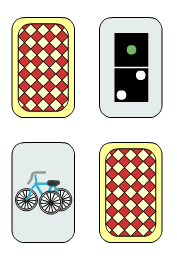Or search by topic
Number and algebra
Geometry and measure
Probability and statistics
Working mathematically
Advanced mathematics
For younger learners
Matching Numbers for Two



- Problem
- Getting Started
Here's a game to play with an adult!

How do you play?
You'll need an adult to play with.
You can print out these cards or use the interactivity below. Take it in turns to turn the cards over. Can you match the pictures? What do you need to look for?
This game helps children see numbers in many different ways. This can help them to develop the abstract idea of the numbers - this is known as 'the two-ness of two'.
Easier version: instead of turning over the cards, focus on sorting the printed cards into matching sets.
Harder version: children can use these blank cards to make their own sets of additional cards with different numbers on.
There's a group version of this game here.
You may also like
Buzzy Bee
Buzzy Bee was building a honeycomb. She decorated the honeycomb with a pattern using numbers. Can you discover Buzzy's pattern and fill in the empty cells for her?
Fair Exchange
In your bank, you have three types of coins. The number of spots shows how much they are worth. Can you choose coins to exchange with the groups given to make the same total?
Missing Middles
Can you work out the domino pieces which would go in the middle in each case to complete the pattern of these eight sets of three dominoes?

